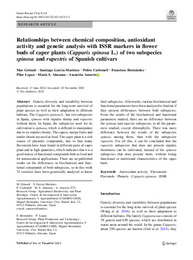Por favor, use este identificador para citar o enlazar este ítem:
https://hdl.handle.net/11000/35971Registro completo de metadatos
| Campo DC | Valor | Lengua/Idioma |
|---|---|---|
| dc.contributor.author | Grimalt Trò, Maria del Mar | - |
| dc.contributor.author | García Martínez, Santiago | - |
| dc.contributor.author | Carbonell, Pedro | - |
| dc.contributor.author | Hernández, Francisca | - |
| dc.contributor.author | Legua, Pilar | - |
| dc.contributor.author | Almansa Pascual de Riquelme, María Soledad | - |
| dc.contributor.author | Amorós, Asunción | - |
| dc.contributor.other | Departamentos de la UMH::Biología Aplicada | es_ES |
| dc.date.accessioned | 2025-03-13T13:15:56Z | - |
| dc.date.available | 2025-03-13T13:15:56Z | - |
| dc.date.created | 2021 | - |
| dc.identifier.citation | Genetic Resources and Crop Evolution Volume 69, pages 1451–1469, (2022) | es_ES |
| dc.identifier.issn | 1573-5109 | - |
| dc.identifier.issn | 0925-9864 | - |
| dc.identifier.uri | https://hdl.handle.net/11000/35971 | - |
| dc.description.abstract | Genetic diversity and variability between populations is essential for the long-term survival of plant species as well as their adaptation to different habitats. The Capparis spinosa L. has two subspecies in Spain, spinosa with stipules thorny and rupestris without them. In Spain, the subspecies used for its cultivation is spinosa, which is difficult to manipulate due to its stipules thorny. The capers, unripe fruits and tender shoots are used as food. The caper plant is a rich source of phenolic compounds, due to that many flavonoids have been found in different parts of caper plant and in high quantities, which indicates that it is a good source of functional compounds both as food and for nutraceutical applications. There are no published works on the differences in biochemical and func- tional compounds of both subspecies, so in this work 32 varieties have been genetically analyzed to know their subspecies. Afterwards, various biochemical and functional parameters have been analyzed to find out if they present differences between both subspecies. From the results of the biochemical and functional parameters studied, there are no difference between the spinosa and rupestis subspecies, in all the param- eters studied, except chlorophylls. There was more difference between the results of the subspecies spinosa among them, than with the subspecies rupestris. For all this, it can be concluded that the rupestris subspecies that does not present stipules thorniness can be cultivated, instead of the spinosa subspecies that does present them, without losing functional or nutritional characteristics of the caper buds. | es_ES |
| dc.format | application/pdf | es_ES |
| dc.format.extent | 19 | es_ES |
| dc.language.iso | eng | es_ES |
| dc.publisher | Springer | es_ES |
| dc.rights | info:eu-repo/semantics/opendAccess | es_ES |
| dc.rights | Attribution-NonCommercial-NoDerivatives 4.0 Internacional | * |
| dc.rights.uri | http://creativecommons.org/licenses/by-nc-nd/4.0/ | * |
| dc.subject | Antioxidant activity | es_ES |
| dc.subject | Flavonols | es_ES |
| dc.subject | Flavonoids | es_ES |
| dc.subject | Phenols | es_ES |
| dc.subject | Capparis spinosa | es_ES |
| dc.subject | ISSR | es_ES |
| dc.title | Relationships between chemical composition, antioxidant activity and genetic analysis with ISSR markers in flower buds of caper plants (Capparis spinosa L.) of two subspecies spinosa and rupestris of Spanish cultivars | es_ES |
| dc.type | info:eu-repo/semantics/article | es_ES |
| dc.relation.publisherversion | https://doi.org/10.1007/s10722-021-01312-3 | es_ES |

Ver/Abrir:
Grimalt2021_Article_RelationshipsBetweenChemicalCo.pdf
971,95 kB
Adobe PDF
Share:
.png)
